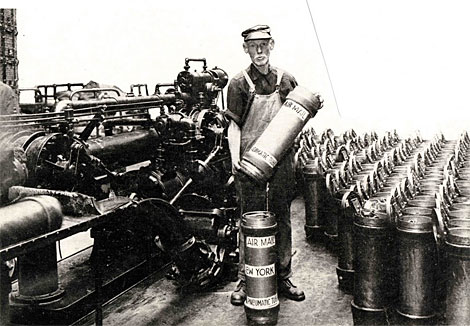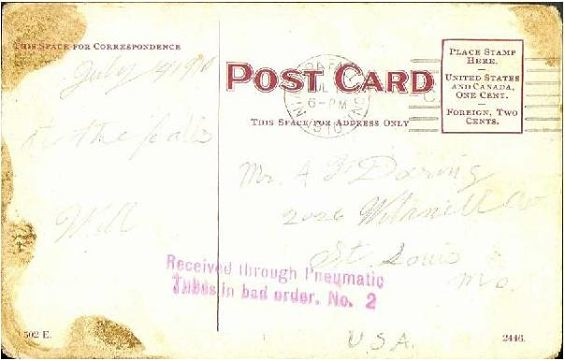
In 1905, the St. Louis post office built a two-mile pneumatic tube system to deliver mail between the train station and the post office. It was expensive to maintain ($17,000 per year per mile of tube) and ruined a lot of mail.
From Aimee Levitt's article in the Riverfront Times:
St. Louis's tubes ran a little less than two miles; by contrast, New York's system, the largest in the U.S., was 27 miles, not counting the tube that ran under the East River to Brooklyn. It was also the least efficient: Most of the time, the tubes, which were open from 4 a.m. to midnight six days a week, ran at only 26 percent capacity, except between 7 and 9 a.m. when the two big mail trains arrived. Then it was overwhelmed and the mail would be delayed for as long as 20 minutes. That was about five times as long as it took normally for the capsules to whiz their way from the train station to the main post office.Here's USPO's pro/con list of the system:
The tubes themselves were eight inches in diameter. The capsules were seven inches in diameter and 22 inches long; they could each hold about 600 letters. They didn't look much different from the capsules that are still used in banks. (Why mess with good technology?) Underground, they traveled at 30 miles per hour, propelled along by a system of fans and pumps that would either blow them forward or suck them backward.
Advantages:By 1916 it was obsolete, replaced by mail trucks.
1. High rate of speed between stations for limited quantities of mail.
2. Freedom from surface congestion.
Limitation and disadvantages:
1. Only five pounds of mail could by carried in each container; and all classes of mail could not be carried.
2. The minimum time between dispatches is 15 seconds allowing only 20 pounds of letter mail each minute. Therefore, vehicle service would be required to carry mail during heavy volume times.
3. The inability to carry special delivery parcels due to the size of the carriers.
4. The relays at station are built in delays but they are unavoidable requiring all stations to be manned and open during operation.
5. The inability to dispatch between intermediate stations during continuous transmission between any two points.
6. Inability to dispatch to railroad companies without additional handling.
7. Complaints resulting from careless locking and accidental opening of container in transit causing damaged mail.
8. Dampness and oil damage to mail.
9. Service interruptions block an entire line.
10. Congestion from heavy mail volumes.
11. Equipment takes up rented building space.
12. Excessive costs.
 Too bad they shut it down. How cool would it be to get mail with a stamp
that says: "Received through Pneumatic Tubes in bad order?"
Too bad they shut it down. How cool would it be to get mail with a stamp
that says: "Received through Pneumatic Tubes in bad order?"The secret History of the St. Louis Post Office and its amazing pneumatic tube

No comments:
Post a Comment